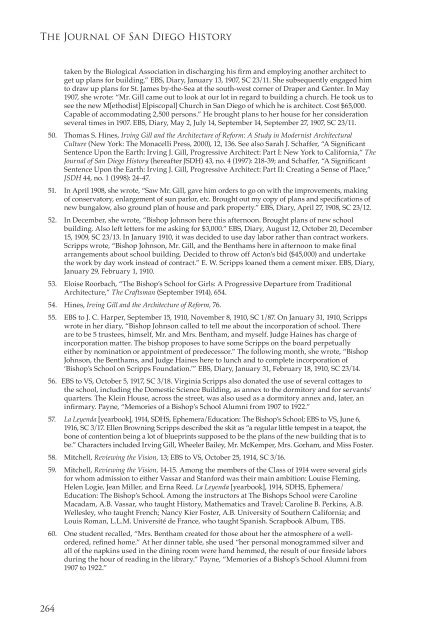Complete Journal Issue - San Diego History Center
Complete Journal Issue - San Diego History Center
Complete Journal Issue - San Diego History Center
Create successful ePaper yourself
Turn your PDF publications into a flip-book with our unique Google optimized e-Paper software.
The <strong>Journal</strong> of <strong>San</strong> <strong>Diego</strong> <strong>History</strong><br />
taken by the Biological Association in discharging his firm and employing another architect to<br />
get up plans for building.” EBS, Diary, January 13, 1907, SC 23/11. She subsequently engaged him<br />
to draw up plans for St. James by-the-Sea at the south-west corner of Draper and Genter. In May<br />
1907, she wrote: “Mr. Gill came out to look at our lot in regard to building a church. He took us to<br />
see the new M[ethodist] E[piscopal] Church in <strong>San</strong> <strong>Diego</strong> of which he is architect. Cost $65,000.<br />
Capable of accommodating 2,500 persons.” He brought plans to her house for her consideration<br />
several times in 1907. EBS, Diary, May 2, July 14, September 14, September 27, 1907, SC 23/11.<br />
50. Thomas S. Hines, Irving Gill and the Architecture of Reform: A Study in Modernist Architectural<br />
Culture (New York: The Monacelli Press, 2000), 12, 136. See also Sarah J. Schaffer, “A Significant<br />
Sentence Upon the Earth: Irving J. Gill, Progressive Architect: Part I: New York to California,” The<br />
<strong>Journal</strong> of <strong>San</strong> <strong>Diego</strong> <strong>History</strong> (hereafter JSDH) 43, no. 4 (1997): 218-39; and Schaffer, “A Significant<br />
Sentence Upon the Earth: Irving J. Gill, Progressive Architect: Part II: Creating a Sense of Place,”<br />
JSDH 44, no. 1 (1998): 24-47.<br />
51. In April 1908, she wrote, “Saw Mr. Gill, gave him orders to go on with the improvements, making<br />
of conservatory, enlargement of sun parlor, etc. Brought out my copy of plans and specifications of<br />
new bungalow, also ground plan of house and park property.” EBS, Diary, April 27, 1908, SC 23/12.<br />
52. In December, she wrote, “Bishop Johnson here this afternoon. Brought plans of new school<br />
building. Also left letters for me asking for $3,000.” EBS, Diary, August 12, October 20, December<br />
15, 1909, SC 23/13. In January 1910, it was decided to use day labor rather than contract workers.<br />
Scripps wrote, “Bishop Johnson, Mr. Gill, and the Benthams here in afternoon to make final<br />
arrangements about school building. Decided to throw off Acton’s bid ($45,000) and undertake<br />
the work by day work instead of contract.” E. W. Scripps loaned them a cement mixer. EBS, Diary,<br />
January 29, February 1, 1910.<br />
53. Eloise Roorbach, “The Bishop’s School for Girls: A Progressive Departure from Traditional<br />
Architecture,” The Craftsman (September 1914), 654.<br />
54. Hines, Irving Gill and the Architecture of Reform, 76.<br />
55. EBS to J. C. Harper, September 15, 1910, November 8, 1910, SC 1/87. On January 31, 1910, Scripps<br />
wrote in her diary, “Bishop Johnson called to tell me about the incorporation of school. There<br />
are to be 5 trustees, himself, Mr. and Mrs. Bentham, and myself. Judge Haines has charge of<br />
incorporation matter. The bishop proposes to have some Scripps on the board perpetually<br />
either by nomination or appointment of predecessor.” The following month, she wrote, “Bishop<br />
Johnson, the Benthams, and Judge Haines here to lunch and to complete incorporation of<br />
‘Bishop’s School on Scripps Foundation.’” EBS, Diary, January 31, February 18, 1910, SC 23/14.<br />
56. EBS to VS, October 5, 1917, SC 3/18. Virginia Scripps also donated the use of several cottages to<br />
the school, including the Domestic Science Building, as annex to the dormitory and for servants’<br />
quarters. The Klein House, across the street, was also used as a dormitory annex and, later, an<br />
infirmary. Payne, “Memories of a Bishop’s School Alumni from 1907 to 1922.”<br />
57. La Leyenda [yearbook], 1914, SDHS, Ephemera/Education: The Bishop’s School; EBS to VS, June 6,<br />
1916, SC 3/17. Ellen Browning Scripps described the skit as “a regular little tempest in a teapot, the<br />
bone of contention being a lot of blueprints supposed to be the plans of the new building that is to<br />
be.” Characters included Irving Gill, Wheeler Bailey, Mr. McKemper, Mrs. Gorham, and Miss Foster.<br />
58. Mitchell, Reviewing the Vision, 13; EBS to VS, October 25, 1914, SC 3/16.<br />
59. Mitchell, Reviewing the Vision, 14-15. Among the members of the Class of 1914 were several girls<br />
for whom admission to either Vassar and Stanford was their main ambition: Louise Fleming,<br />
Helen Logie, Jean Miller, and Erna Reed. La Leyenda [yearbook], 1914, SDHS, Ephemera/<br />
Education: The Bishop’s School. Among the instructors at The Bishops School were Caroline<br />
Macadam, A.B. Vassar, who taught <strong>History</strong>, Mathematics and Travel; Caroline B. Perkins, A.B.<br />
Wellesley, who taught French; Nancy Kier Foster, A.B. University of Southern California; and<br />
Louis Roman, L.L.M. Université de France, who taught Spanish. Scrapbook Album, TBS.<br />
60. One student recalled, “Mrs. Bentham created for those about her the atmosphere of a wellordered,<br />
refined home.” At her dinner table, she used “her personal monogrammed silver and<br />
all of the napkins used in the dining room were hand hemmed, the result of our fireside labors<br />
during the hour of reading in the library.” Payne, “Memories of a Bishop’s School Alumni from<br />
1907 to 1922.”<br />
264







![[PDF] The Journal of San Diego History Vol 52: Nos 1 & 2](https://img.yumpu.com/25984149/1/172x260/pdf-the-journal-of-san-diego-history-vol-52-nos-1-2.jpg?quality=85)

![[PDF] The Journal of San Diego History - San Diego History Center](https://img.yumpu.com/25984131/1/172x260/pdf-the-journal-of-san-diego-history-san-diego-history-center.jpg?quality=85)






